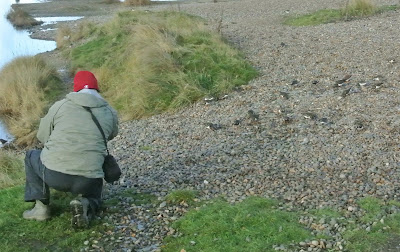First stop today was in Cannock and to meet up with one of @Staffbirdnews followers. We met Georgia who very kindly tried to find the RING-NECKED PARAKEET that had been seen in the area recently. She also persuaded the neighbour in whose garden it had fed to come and have a chat with us. Unfortunately, the RNP didn't play ball today.
We met up with Phill Locker and Phil Jones and formed a Clayhead-convoy that weaved its way for the rest of the day through Staffordshire. We called in at Belvide and tried to see as many of its current star birds as we could. We walked up to the west end where the adult Greenland White-fronted Goose was with the Canada Geese on the north shore. A few birders are now realising that this is quite a rare bird in Staffs and there is quite a bit of interest in it. The last one in the county was in 2009 at Whitemoor/Croxall, but that didn't attract much of a crowd. In fact when I went down with PJ to see it, the crowd was only three!
The Belvide GWFG
|
1949
|
Belvide Resr
|
Five (pair and
three immatures ) from October 30th to February 26th 1950.
|
|
1970
|
Belvide Resr
|
Four adults in
a flock of Eurasian birds on February 14th.
|
|
2004
|
Doxey
|
A juvenile on
January 25th.
|
|
2009
|
Whitemoor Haye
|
A first-winter
from February 26th to March 2nd, also visiting Croxall Lakes.
|
We walked up to the west end and had excellent views of the singing Cetti's Warbler, showing well in a nice thin hedgerow with the sun shining on it. We could also see the 1st winter drake Scaup from the lane. Three birds down, and we walked back down to the Scott hide for the BITTERN. Unfortunately, it was being rather elusive today, but we did have distant views of the two immature Long-tailed Ducks. As Meatloaf once sang, four out of five ain't bad.
Just as we were arriving at Belvide, we received news from Ian Grant (@Ian_m_grant) at Aqualate. We already knew there were five COMMON SCOTER present, but he'd also found a female VELVET SCOTER. After finishing at Belvide, we made the short journey over to Aqualate. In the hide, Ian was still present, and had been joined by Richard Powell. We were hoping that the female Velvet Scoter wasn't feeding down at the far end, and we were pleasantly surprised to see it feeding with four Tufted Ducks in the middle of the water. I managed to see two of the female Common Scoter, making it the first time I'd seen two species of Scoter together in Staffs. Quite a crowd gathered in the hide, and we were soon joined by Clayheads No.1 Stalker Ian - the second weekend running he's managed to find us!
Nice set of images all dazzled by the bright winter sun!
A quality scarce bird in Staffordshire, this is only the 5th record in the county since 1990. I've managed to see three now; the two immatures at Chasewater in Dec 1986 and the incredible sub adult drake at Westport Lake in 1992. Below is a photograph taken by WJL
Also at Aqualate, Marsh Tits came down to the feeders. PJ took this photo
and while sitting in the hide, PJ did this excellent drawing of the Velvet Scoter.
And finally, this week I received an email from Richard of Uttoxeter Quarry. He writes "I really think all your song choices are excellent. Simply all time classics. But you seem to constantly forget one of the all time greats". You are right Richard of Uttoxeter Quarry. Hopefully this song will make amends!






















